MB Stories
Reshaping the landscape of coagulation diagnostics
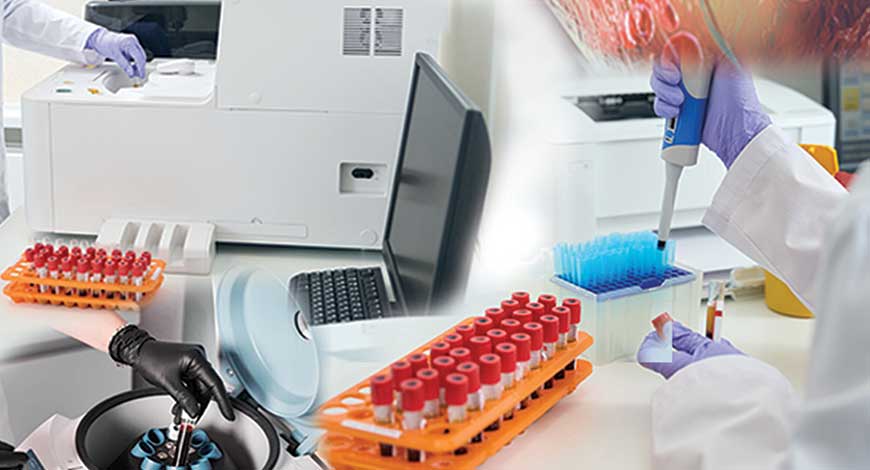
Propelling coagulation diagnostics into a realm of enhanced precision, efficiency, and patient-centered care, automation, and innovative assays is reshaping the landscape of coagulation testing.
Coagulation diagnostics, a critical component of medical practice, have come a long way in their journey from foundational bench research to practical bedside applications. Exploring the intricate journey of coagulation, from foundational bench research to practical bedside applications, uncovering innovations, patient care, and the future of healthcare makes an interesting study. The instruments and reagents are the foundation upon which modern coagulation diagnostics stand, supporting medical professionals in making critical decisions, particularly in scenarios involving surgery, trauma, or chronic conditions like thrombosis or bleeding disorders.
Indian market dynamics
The market for coagulation instruments and reagents over the past two years has seen a distinct shift, with higher growth being reported from the Tier-II and Tier-III cities. The corporate lab chains have decentralized operations and now the tests are also being conducted in these cities. With increased awareness, and timely transport of samples in the desired condition remaining a challenge, testing is being done in the same city as the point of sample collection. The market has not degrown in the larger cities; the workload has merely shifted, and the number of tests conducted decreased.
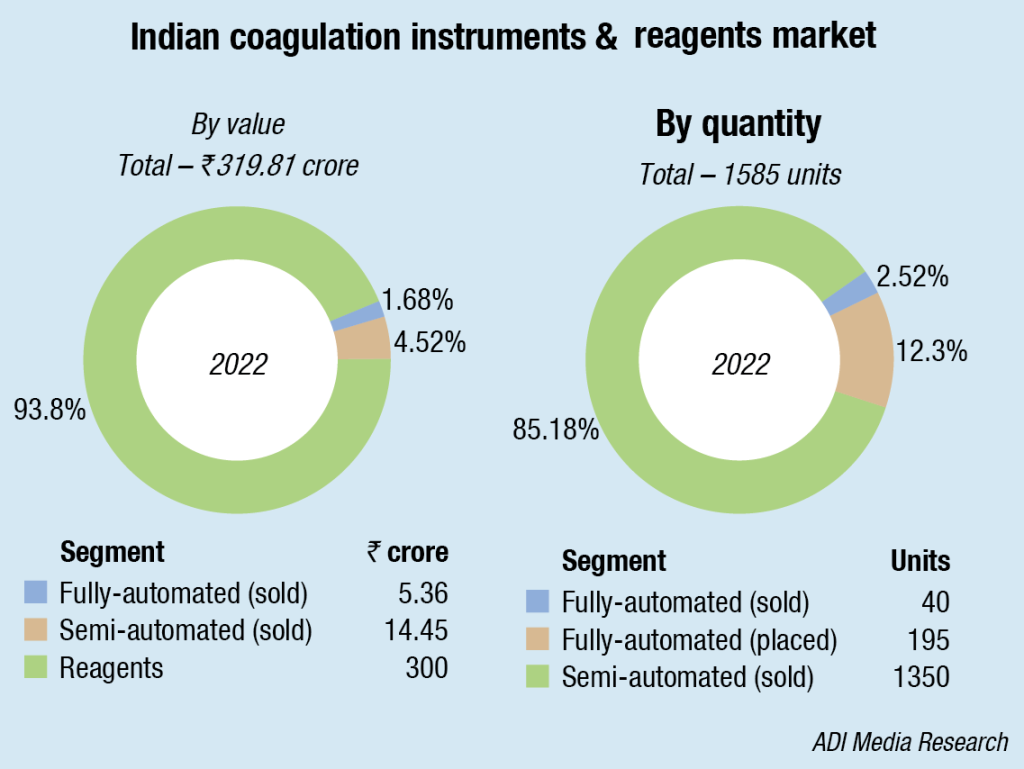
The Indian market for coagulation instruments and reagents in 2022 is estimated at ₹319.81 crore, an 8.5-percent increase over 2021. The one-channel analyzers hold an 11-percent share, with a distinct preference perceived for its 4-channel counterpart.
The market continues to be dominated by Stago and Werfen, with Sysmex also in the running. As the Covid pandemic receded, the number of D-dimer tests conducted saw a major decline.
|
Indian coagulation instruments players – 2022 |
|
| Tier 1 | Stago (including Trinity) |
| Tier 2 | Werfen India and Sysmex |
| Tier 3 | Transasia |
| Others | Tulip, Agappe, Compact Diagnostics , CPC Diagnostics, HUMAN, Meril Diagnostics, Roche and Trivitron |
| *Vendors are placed in different tiers on the basis of their sales contribution to the overall revenues of the Indian coagulation market. | |
| ADI Media Research | |
Global market scenario
The global coagulation analyzer market was valued at USD 4183.71 million in 2022 and is expected to reach USD 6690.08 million by 2030 at a CAGR of 6.0 percent, according to the Insight Partners. The blood coagulation analyzer market has witnessed continuous technological advancements, leading to the development of more accurate and efficient analyzers. Such innovations enhance testing capabilities and provide real-time results, improving patient care and diagnosis.
Factors, such as the rising incidence of coagulation disorders like deep vein thrombosis (DVT), pulmonary embolism, hemophilia, thrombophilia, and other bleeding disorders, have generated a significant demand for blood coagulation analyzers, thereby driving the global market for coagulation testing products.
Additionally, the growing development of point-of-care (POC) coagulation analyzers by the key market players will lead to the increase in the demand for coagulation testing across the globe. These advanced devices provide quick and accurate results, making them highly suitable for emergency rooms, outpatient clinics, and other healthcare settings.
Moreover, the introduction of new and innovative blood coagulation testing devices, the growth in the number of surgical procedures, and the increasing number of blood transfusions are also expected to boost the demand for coagulation testing devices.
High competition and need for substantial investment in R&D activities are the major challenges faced by the market players. Thus, it is estimated that this aspect will accelerate the revenue of the blood coagulation testing market globally.
Regional insights. North America accounts for the major blood coagulation testing market with USD 1.145 billion in 2022 with a share of around 45.80 percent. The reason behind this is the increasing investment by government bodies and population awareness. Furthermore, the increase in the number of surgical procedures and blood transfusions along with the growth of senior population is also one of the reasons for the largest market share of this region.
The European blood coagulation tests accounted for the second-largest market share. This growth can be attributed to the increasing number of research and development activities, government support for healthcare, and the growth of health facilities present in the region.
The Asia-Pacific market is anticipated to demonstrate a significant revenue growth rate throughout the forecast period, driven by an intense demand for coagulation testing in the region and growing awareness about the importance of early diagnosis and treatment, along with the growing investments in the healthcare sector from the key market players.
The key players operating in the blood coagulation testing global market are Abbott Rapid Diagnostics (formally Alere), Diagnostica Stago, Helena Laboratories, Instrumentation Laboratory, International Technidyne Corporation (Warburg Pincus), Nihon Kohden Corp., Roche Diagnostics, Siemens AG, Sysmex Corporation, and Thermo Fisher Scientific Inc.
Coagulation laboratories provide a comprehensive set of clinical tests, with a wide variety of routine and specialized coagulation assays, and expert interpretations for the diagnosis and monitoring of bleeding and thrombotic disorders in hospitalized patients and outpatients. The assays range from routine panels with prothrombin time (PT), activated partial prothrombin time (APTT), and fibrinogen (Fib) to more specific protein activity or antigen measurements.
Advancements in coagulation testing
 Inderjeet Singh Bhatia
Inderjeet Singh Bhatia
Product Manager Coagulation,
Transasia Bio-Medicals Ltd.
Coagulation tests help evaluate the blood clotting mechanism in an individual. In recent times, the increasing prevalence of blood disorders, CVDs, and geriatric population is expected to contribute to the coagulation testing market.
Developments in testing solutions
Coagulation tests are mainly performed by hospitals or attached labs, as compared to standalone labs. Routine parameters, such as PT and APTT contribute 80 percent of the tests. The diagnostic devices utilized to perform these tests have come a long way from quantifying optical density of clots in a cuvette to detection of clotting factors. The analyzers gradually evolved by adding different technologies to the same instrument. These include optical detection of clot formation, chromogenic substrates, latex agglutination immunoassays, and turbidimetry.
Further, manufacturers are focused on providing systems with high throughput, reliability, easy-to-use advanced software with LJ graphs and calibration curves for minimum errors. Advances in technology have resulted in greater capability, productivity, sensitivity, specificity, and ultimately improvement in the clinical care of patients. Transasia Bio-Medicals Ltd. offers semi- and fully-automated coagulation analyzers and reagents that are innovative and technologically advanced. The product portfolio covers hemophilia profile, thrombophilia profile, D-Dimer, calibrators, and controls.
Future perspectives
With increase in screening for coagulation and therapeutic monitoring, the market is witnessing a shift toward nex-gen POCT. The high cost of fully automated analyzers is bringing about this market trend. While large hospitals and lab chains with high workload continue to prefer fully automated systems, compact, cost-effective POCT devices are being preferred by labs with less workload. Also, AI and machine learning-based algorithms may very likely find place within future novel POC blood coagulation measurement technologies.
The other upcoming technologies include T2 magnetic resonance, acoustic waves, laser speckle rheology, and infrared spectroscopy. With these technologies, the analyzers will offer advanced testing for Von Willebrand disease, platelet aggregation, heparin-induced thrombocytopenia, and chromogenic factor assays, D-dimer, and anti-phospholipid antibodies.
In this rapidly evolving field, two pivotal drivers of growth have emerged – automation and innovative assays. These drivers are reshaping the landscape of coagulation diagnostics, enhancing patient care, and illuminating the path to the future of healthcare. They are the growth drivers propelling coagulation diagnostics into a realm of enhanced precision, efficiency, and patient-centered care.
Automation
Coagulation diagnostics plays a pivotal role in ensuring that blood behaves both as a liquid and a solid, maintaining the balance necessary for our well-being. As medical science progresses and the demands on healthcare systems increase, the need for more efficient and precise coagulation diagnostics has become paramount.
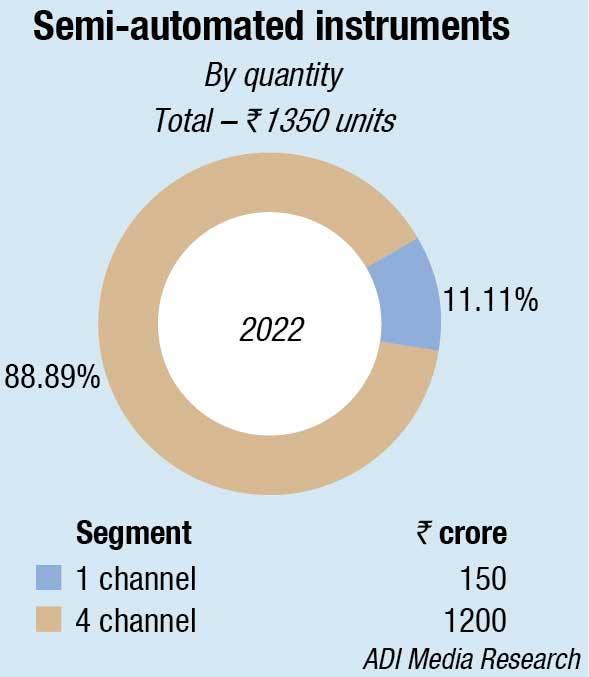
Coagulation diagnostics have come a long way from manual testing procedures to highly automated systems. Automation has revolutionized the field, making diagnostic processes faster, more accurate, and capable of handling a higher volume of tests. It has drastically reduced the potential for human error, ensuring that patient samples are processed consistently and reliably.
The synergy between automation and precision is a hallmark of modern coagulation diagnostics. Automation minimizes human error, reduces processing times, and handles a high volume of tests efficiently. This not only benefits healthcare providers by improving diagnostic accuracy but also offers numerous advantages for patients.
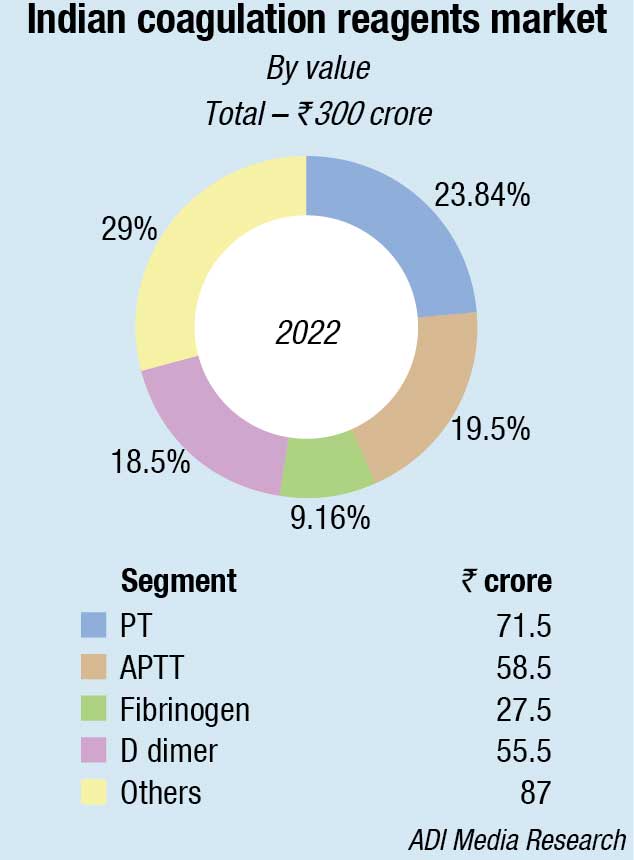
Fast and reliable results mean quicker diagnoses and treatment initiation. In cases of critical medical conditions, such as trauma or surgeries, rapid coagulation tests are indispensable. Automated systems can deliver results in a matter of minutes, allowing healthcare providers to make informed decisions promptly.
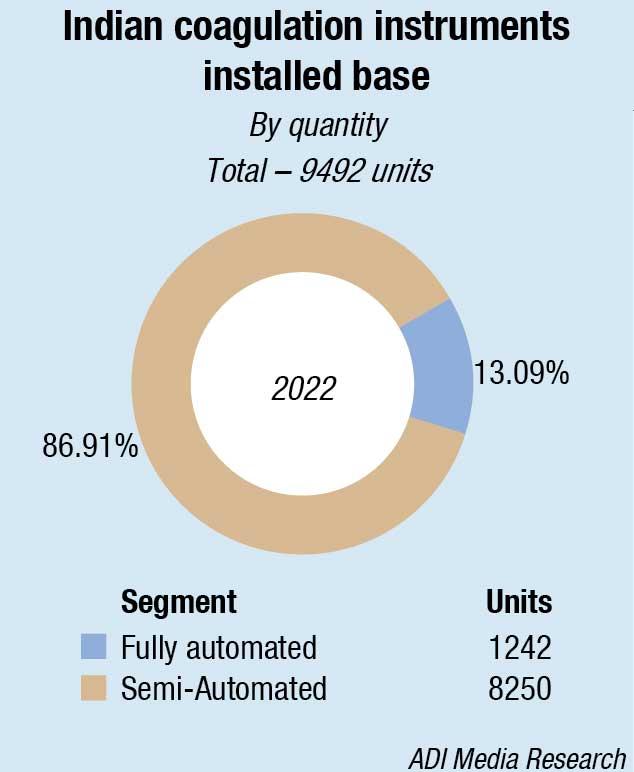
Moreover, automation enhances the quality of diagnostic data. The consistency offered by automated systems ensures that test results are reliable and reproducible. This reliability is especially critical for monitoring patients on anticoagulant therapies, where minor variations in results can have significant consequences.
Artificial intelligence (AI) uses a series of algorithms mimicking human intelligence. Applications of AI can be used for diagnostic procedures, including forecasting events, predicting risk for disease, monitoring anticoagulants, etc. AI can aid in foreseeing adverse events minimizing bleeding and or clotting events. There are many applications in coagulation that would lead to better patient outcomes and enhance diagnosis and monitoring of anticoagulation.
AI has made remarkable inroads into the field of coagulation diagnostics, offering innovative solutions that go beyond what traditional methods can achieve. AI’s capabilities, from machine learning to deep learning, have the potential to significantly enhance coagulation diagnostics.
One of the key applications of AI in coagulation is the prediction of patient outcomes based on coagulation profiles. By analyzing vast amounts of patient data, AI can identify patterns and correlations that might not be apparent to human diagnosticians. This can lead to early detection of coagulation disorders or the ability to predict patient responses to specific treatments.
Additionally, AI is utilized to optimize the calibration of coagulation analyzers, ensuring that test results are accurate and consistent across different machines. Through continuous learning and adaptation, AI can fine-tune coagulation tests, making them more reliable and reducing the chances of false positives or negatives.
Robotics, coupled with AI, is a powerful force in the realm of coagulation diagnostics. The integration of robotics into diagnostic processes further enhances efficiency and quality. Robotic systems are employed to handle the entire coagulation testing process, from sample preparation to result reporting. These systems reduce the need for manual intervention, minimizing the risk of human error, and ensuring consistent and accurate results.
Moreover, robots can process a high volume of samples in a shorter time, making them an invaluable addition to laboratories with a heavy workload. The AI component in these systems continually learns and adapts to optimize processes, further improving efficiency. As new data becomes available and patterns emerge, the AI can fine-tune the testing procedures and algorithms, providing an ever-evolving approach to coagulation diagnostics.
Advancing coagulation with innovative reagents and instruments
 Srinivas Naidu
Srinivas Naidu
Senior Product Manager-Coagulation Marketing,
Sysmex India Pvt Ltd
In recent years, the Indian coagulation market has been witnessing several growing trends. Here are a few notable ones:
- Increasing demand for point-of-care testing. There is a growing need for quick and accurate testing in coagulation disorders. Point-of-care testing (POCT) devices, which provide rapid results at the patient’s bedside, are becoming more popular in India.
- Expansion of hemophilia treatment centers. Hemophilia treatment centers (HTCs) are specialized facilities that provide comprehensive care for individuals with bleeding disorders. These centers are being set up in major cities across India, providing access to advanced treatments and improved patient outcomes.
- Adoption of advanced coagulation testing methods. Traditional coagulation tests, such as prothrombin time (PT) and activated partial thromboplastin time (aPTT), are being complemented or replaced by newer assays like chromogenic assays, automated platelet aggregometry. These modern methods offer better precision, accuracy, and monitoring capabilities.
- Rise in awareness and screening for thromboembolic conditions. With an increasing awareness about thromboembolic diseases like deep vein thrombosis (DVT) and pulmonary embolism (PE), more people are undergoing screening tests for early detection and prevention. This has led to a greater demand for coagulation panels and D-dimer tests.
- Availability of novel anticoagulant drugs. There has been a significant development in the availability of novel oral anticoagulants (NOACs) in the Indian market. These medications offer advantages over traditional anticoagulants, such as better safety profiles, convenient dosing, and reduced need for monitoring.
These trends reflect a positive growth trajectory for the Indian coagulation market, indicating advancements in diagnostics, treatments, and overall patient care.
Sysmex has been at the forefront of innovation in coagulation, revolutionizing diagnostics in this field. Their cutting-edge technologies have advanced the accuracy and efficiency of coagulation testing. With Fully automated analyzers, Sysmex enables rapid and precise measurement of clotting factors, platelet function, and other coagulation parameters. Their innovative reagents and algorithms enhance the detection of abnormalities, aiding in the diagnosis and monitoring of bleeding disorders and thrombotic conditions. Sysmex’s commitment to continuous research and development has paved the way for improved patient care, empowering healthcare professionals with reliable coagulation diagnostic solutions.
Innovation
Coagulation testing is a crucial aspect of modern healthcare, allowing medical professionals to assess and manage the risk of bleeding or thrombosis in patients. In recent years, the field of coagulation testing has seen significant advancements, primarily through the identification and utilization of biomarkers. These biomarkers serve as invaluable tools in diagnosing and monitoring coagulation disorders, providing a more comprehensive understanding of a patient’s condition.
One of the recent trends in coagulation testing is the exploration of novel biomarkers that offer improved sensitivity and specificity.
Glycomics, the study of glycans or carbohydrates in biological systems, is gaining traction as a potential source of innovative biomarkers. Changes in glycan structures on proteins, such as fibrinogen can provide valuable insights into coagulation disorders, shedding light on the intricacies of hemostasis and thrombosis. This interdisciplinary approach combines chemistry and biology, emphasizing the importance of glycomics in coagulation testing.
Expanding our knowledge in glycomics, there is another approach that takes us into the realm of proteomics, another branch of study that is proving instrumental in identifying biomarkers in coagulation. Proteomics involves the large-scale analysis of proteins, and it plays a vital role in coagulation testing by pinpointing specific proteins associated with hemostasis. This comprehensive understanding of protein profiles within the coagulation cascade enables researchers to identify potential biomarkers with high accuracy, contributing to the precision of diagnostic tests. The integration of glycomics and proteomics serves as a prime example of how interdisciplinary research is driving innovation in coagulation testing.
Moving forward, it is essential to explore how these biomarkers are implemented in clinical practice. The discovery of novel biomarkers in coagulation testing holds great promise, but their translation into practical diagnostic tools is a critical step. Established tests like prothrombin time (PT) and activated partial thromboplastin time (aPTT) remain cornerstones in coagulation testing.
However, these traditional assays may lack the sensitivity required to detect subtle changes in coagulation biomarkers. Biomarkers identified through glycomics and proteomics are primed to fill this gap, contributing to a more accurate diagnosis of coagulation disorders.
With an understanding of the significance of these biomarkers, also consider their impact on patient care. Accurate and timely diagnosis is paramount in coagulation disorders, as patients often require specific treatment plans to manage bleeding or thrombotic risks effectively. The integration of novel biomarkers into diagnostic tests can lead to more precise patient stratification, allowing healthcare providers to tailor treatment strategies based on individual biomarker profiles. Such personalized approaches can result in improved patient outcomes and reduced complications.
Additionally, advancements in coagulation testing biomarkers are helpful in assessing the effectiveness of anticoagulant therapies. Patients receiving anticoagulants for various medical conditions require consistent monitoring to ensure that their coagulation remains within the desired therapeutic range. The incorporation of sensitive biomarkers can help healthcare providers adjust anticoagulant dosages accurately, reducing the risk of adverse events like bleeding or thrombosis. Therefore, biomarkers in coagulation testing are not only diagnostic tools but also essential components in the management of coagulation-related disorders.
Furthermore, the ability to identify coagulation biomarkers has broader implications in research and drug development. Biomarker-driven studies facilitate the discovery of potential targets for novel therapeutic interventions. By understanding the intricate details of coagulation through the lens of biomarkers, researchers can develop more targeted and effective treatments for coagulation disorders. This approach opens up new avenues for drug development and the potential to improve patient care by providing more tailored and efficient treatments.
Point of care
The advent of point-of-care (POC) coagulation testing has revolutionized the way healthcare providers manage coagulopathies, major hemorrhages, and thromboembolic events in these challenging scenarios.
Swift and informed decision making. In emergency and critical care, healthcare providers are often faced with patients experiencing life-threatening conditions, such as trauma, massive bleeding, or sepsis. In these critical moments, time is of the essence, and rapid diagnostic insights can be pivotal. POC coagulation testing offers a solution by providing real-time data at the patient’s bedside. This expedites the diagnostic process and enables clinicians to make informed, evidence-based decisions promptly. Such quick responses can be life-saving, particularly when determining whether to administer blood products, hemostatic agents, or anticoagulants.
Optimized transfusion management. One of the most immediate and tangible benefits of POC coagulation testing in emergency and critical care is the optimization of transfusion management. Major hemorrhages and coagulopathies often necessitate blood component therapy, including packed red blood cells, platelets, and fresh frozen plasma. POC testing helps healthcare providers determine the precise requirements for these components. By assessing parameters like prothrombin time (PT), activated partial thromboplastin time (aPTT), and fibrinogen levels on-site, clinicians can tailor transfusion therapy to the patient’s specific coagulation needs. This targeted approach not only conserves precious blood resources but also mitigates the risk of transfusion-related complications.
Tailored hemostatic therapies. Emergency and critical care physicians frequently encounter patients with complex coagulation disorders, such as disseminated intravascular coagulation (DIC) or thrombocytopenia. These conditions demand precise therapeutic interventions. POC coagulation testing empowers clinicians to customize hemostatic therapies. For instance, in patients with DIC, the ability to monitor parameters like D-dimer levels in real time helps in identifying the underlying cause and adjusting treatment strategies accordingly. Whether it involves the administration of clotting factor concentrates, antifibrinolytics, or recombinant coagulation factors, POC testing ensures that therapies are administered with accuracy and timeliness.
Risk reduction and patient safety. In addition to optimizing treatment, POC coagulation testing contributes significantly to patient safety. By providing rapid feedback, POC devices facilitate the early identification of bleeding tendencies or hypercoagulable states. Such early detection helps in preventing thromboembolic events and excessive bleeding complications, both of which are prevalent in emergency and critical care settings. Moreover, it minimizes the risk of adverse events associated with unnecessary treatments or transfusions. As a result, patient safety is greatly enhanced.
Guiding anticoagulation and thrombolysis. In cases of acute ischemic events, such as stroke or myocardial infarction, prompt and accurate assessment of coagulation status is paramount. POC coagulation testing plays a crucial role in guiding anticoagulation and thrombolysis therapies. By measuring parameters like international normalized ratio (INR) and activated clotting time (ACT) on-site, clinicians can determine the patient’s suitability for interventions like tissue plasminogen activator (tPA) administration or anticoagulant therapy. This real-time guidance ensures that these potent treatments are administered safely and effectively.
Improving resource utilization. Emergency and critical care settings often operate under resource constraints. POC coagulation testing assists in resource allocation by reducing unnecessary laboratory tests and expediting diagnosis. As it negates the need to send samples to centralized laboratories and await results, POC devices contribute to efficient resource utilization. This can be especially beneficial in scenarios where time and resources are limited, such as mass casualty incidents or resource-limited healthcare settings.
Tailoring treatments with coagulation diagnostics
Coagulation diagnostics serve as the cornerstone for tailoring treatments to patients with various hematological conditions, and their role in customizing interventions is paramount. Disseminated intravascular coagulation (DIC) is one such complex disorder where coagulation diagnostics play a pivotal role. By analyzing parameters, such as platelet count, prothrombin time (PT), activated partial thromboplastin time (aPTT), and fibrinogen levels, clinicians can precisely identify the underlying coagulation imbalances in DIC patients. This enables the customization of treatments, ensuring they are accurate and targeted, thus reducing complications and adverse events.
One ground-breaking advancement in coagulation diagnostics is the two-component system. This novel technology offers a unique approach to halt internal bleeding. By identifying specific biomarkers in real time and customizing treatments based on individual patient profiles, this innovative system showcases the potential of coagulation diagnostics in revolutionizing healthcare. Not only does it enhance patient safety by minimizing inappropriate therapies but it also significantly improves resource allocation.
The customization of treatments, based on coagulation diagnostics, minimizes the need for unnecessary laboratory tests and treatments, conserving time and resources. The result is a more efficient and cost-effective healthcare system that focuses on personalized, precise care. Coagulation diagnostics stand at the forefront of healthcare personalization, and their impact on healthcare effectiveness is far-reaching, promising safer, more efficient, and patient-centered medical interventions.
Coagulation diagnostics is currently experiencing a significant transformation, driven by various factors and emerging technologies.
The advent of handheld blood gas and electrolyte analyzers has revolutionized POC testing, enabling rapid and efficient assessment of coagulation parameters right at the patient’s side. These portable devices offer healthcare professionals the ability to make immediate clinical decisions, especially in emergency and critical care settings. This trend is aligned with the growing emphasis on timely and personalized patient care.
Additionally, the market is witnessing the rise of next-generation viscoelastic coagulation monitors. These advanced monitors have the capability to provide rapid hemostasis assessment, allowing clinicians to determine the patient’s clotting profile quickly. This is particularly crucial in surgical procedures and emergency cases, where prompt and precise coagulation diagnostics can make a substantial difference in patient outcomes.
The growth of the coagulation diagnostics market is also influenced by regulatory approvals and clearances, such as the FDA’s 510(k) clearance for coagulation analyzers. These approvals not only validate the safety and effectiveness of new diagnostic technologies but also expedite their adoption and integration into clinical practice.
Additionally, the role of special coagulation tests and medical devices is expanding, supported by ongoing research and development efforts. The development of new pipeline products and the analysis of existing devices contribute to the market’s continuous evolution. These specialized tests cater to specific diagnostic needs, such as assessing rare coagulation disorders, and reflect the industry’s commitment to enhancing diagnostic capabilities.
Outlook
As the industry embraces new technologies and forges strategic partnerships, coagulation diagnostics is set to play a pivotal role in the future of healthcare, offering personalized, efficient, and patient-centered medical interventions.
Second Opinion:-














